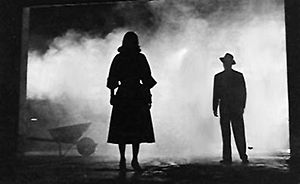- Oneiric (film theory)
-
 The 1950s genre of film noir is noted for its use of dream-like imagery (pictured here: two silhouetted figures in the 1955 film The Big Combo).
The 1950s genre of film noir is noted for its use of dream-like imagery (pictured here: two silhouetted figures in the 1955 film The Big Combo).
In a film theory context, the term oneiric (/oʊˈnaɪrɪk/; "pertaining to dream") refers to the depiction of dream-like states in films, or to the use of the metaphor of a dream or the dream-state to analyze a film. The connection between dreams and films has been long established; "The dream factory" “...has become a household expression for the film industry”.[1] The dream metaphor for film viewing is “one of the most persistent metaphors in both classical and modern film theory”,[2] and it is used by film theorists using Freudian, non-Freudian, and semiotic analytical frameworks.
Contents
History
Early film theorists such as Ricciotto Canudo (1879-1923) and Jean Epstein (1897-1953) argued that films had a dreamlike quality. Raymond Bellour and Guy Rosolato made psychoanalytical analogies between films and the dream state, and claimed that films have a ‘latent’ content that can be psychoanalyzed as if it were a dream. Italian film director Pier Paolo Pasolini argued that dreams carry messages using a common store of signs.[2] Lydia Marinelli states that before the 1930s, psychoanalysts “...primarily attempted to apply the interpretative schemata found in Sigmund Freud's Interpretation of Dreams to films.” More recently, Robert Eberwein has “...cull[ed] dream scenes from the entirety of cinematic history” to establish “...the validity of psychoanalytic terminology in the form of a taxonomy.”[1]
Another way that films and dreams are connected in psychological analysis is by examining the between the cinema exhibition process and the passive spectator. Roland Barthes, a French literary critic and semiotician, described film spectators as being in a “para-oneiric” state, feeling “...sleepy and drowsy as if they had just woken up” when a film ends. Similarly, the French surrealist André Breton argues that film viewers enter a state between being “...awake and falling asleep,” what French filmmaker René Clair called a “dreamlike state.”[2] Edgar Morin's Le cinéma ou l'homme imaginaire (1956) and Jean Mitry's first volume of Esthétique et psychologie du cinéma (1963) also discuss the connection between films and the dream state.
The French surrealist playwright and director Antonin Artaud argued that the American burlesque genre, with its bizarre, lush costumes, and its mixture of dancing girls, comedians, mime artists and striptease artists, has oneiric qualities.[2]
Filmmakers
Filmmakers noted for their use of oneiric or dreamlike elements in their films include Luis Buñuel,[3] Wojciech Has,[4] Sergei Parajanov, Ingmar Bergman, David Cronenberg, Alexander Dovzhenko, Andrei Tarkovsky,[5] Lars von Trier,[6] Krzysztof Kieslowski (e.g., The Double Life of Véronique from 1991)[7], Carlos Atanes[citation needed], Alejandro Jodorowsky, Sergio Leone (particularly Once Upon a Time in America)[citation needed], Orson Welles (particularly his adaptation of Franz Kafka's The Trial), and David Lynch (e.g., Mulholland Drive).[8] Film genres or styles noted for their use of oneiric elements include 1940s and 1950s film noir and surrealist films; moreover, oneiric elements have also been noted in musicals, thriller and horror films and in comic films such as Marx Brothers movies.[9]
See also
- Film noir, which has been noted for its oneiric elements
References
- ^ a b Marinelli, Lydia "Screening Wish Theories: Dream Psychologies and Early Cinema." Science in Context (2006), 19: 87-110
- ^ a b c d Laura Rascaroli. "Like a Dream: A Critical History of the Oneiric Metaphor in Film Theory." Fall 2002.
- ^ Reia-Baptista, Vitor. THE HERETICAL PEDAGOGY OF LUIS BUÑUEL: a study of the pedagogical character of the heresies and moralities in the cinema of Luis Buñuel. Spring, 1987 http://72.14.205.104/search?q=cache:hzcEVwuecHwJ:www.bocc.ubi.pt/pag/_texto.php
- ^ Caes, Chris. Syllabus: ENG 4133 Polish Science Fiction and Fantasy – Films, Fiction, Artwork. University of Florida course bulletin.
- ^ Petric, Vlada. 'Tarkovski's Dream Imagery', Film Quarterly, v. 43, 2 (Winter 89/90), pp. 28-34.
- ^ Hjort, Mette. "Review: Lars von Trier". Senses of Cinema (December 2002).
- ^ Depper, Corin. "Review: The Films of Krzysztof Kieslowski". Scope 4 (February 2006). ISSN 1465-9166.
- ^ Bulkeley, Kelly "Dreaming and the cinema of David Lynch." Dreaming. Vol 13(1), Mar 2003, pp. 49-60.
- ^ Ado Kyrou. Le surréalisme au cinéma (1963), cited by Laura Rascaroli in "Like a Dream: A Critical History of the Oneiric Metaphor in Film Theory". Fall 2002.
Further reading
- Bächler, Odile, 'Images de film, images de rêve; le véhicule de la vision', CinémAction, 50 (1989), pp. 40-46.
- Burns, Gary. 'Dreams and Mediation in Music Video', Wide Angle, v. 10, 2 (1988), pp. 41-61.
- Eberwein, Robert T. Film & the dream screen : a sleep and a forgetting. Princeton, N.J. : Princeton University Press, 1984.
- Halpern, Leslie. Dreams on film : the cinematic struggle between art and science.Jefferson, N.C. : McFarland & Co., 2003.
- Hobson, J. Allan. 1980. "Film and the Physiology of Dreaming Sleep: The Brain as a Camera-Projector." Dreamworks 1(1):9–25.
- Lewin, Bertram D. 'Inferences from the dream screen', International Journal of Psychoanalysis, vol. XXIX, 4 (1948), p. 224.
- Marinelli, Lydia "Screening Wish Theories: Dream Psychologies and Early Cinema." Science in Context (2006), 19: 87-110
- Sparshott, F. E. "Vision and Dream in Film." Philosophic Exchange: Annual Proceedings, vol. 1, pp. 111-124, Summer 1971
Categories:- Film theory
- Film and video terminology
- Film styles
- History of film
- Dreaming and fiction
- Dreaming
Wikimedia Foundation. 2010.
